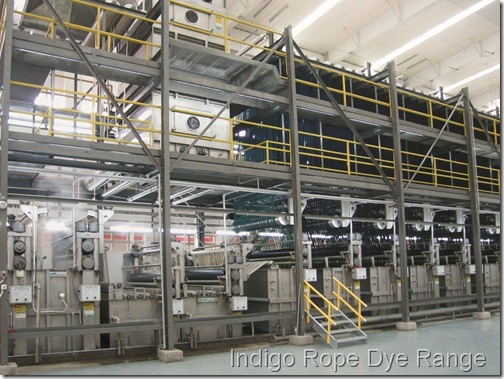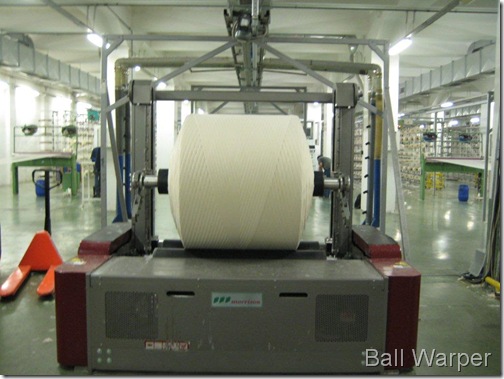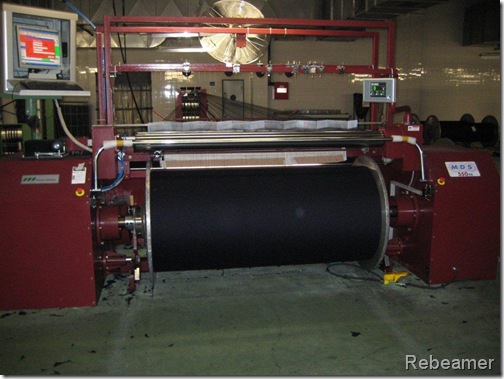Morrison Textile Machinery is a global leader in textile processing machinery. They are particularly famous for its Rope Dyeing Machines for denim fabrics and have installed over 200 machines worldwide. They have shared with us some information on the ‘Duties and Responsbilities of the Indigo Dye operators’ and this info would be useful for many of our readers(with technical background) who come from various denim mills around the world. Here is the summary of the information provided by Morrison.
“Based on our experience in the start-ups and operations of over 200 indigo rope and dye ranges, we have prepared a listing of the basic duties which must be included for the maintaining of a proficient operation of the indigo rope range.
These duties and functions are broken down into into three parts :
- Duties to be performed before starting the range
- Duties to be performed while the range is in operation and
- When it undergoes a normal shutdown.
Normally, 3 operators would run this operation. However, in the beginning, we certainly suggest more during the training period.During this time, the most qualified personnel may be selected to become the head operator or unit supervisor — whatever the title might be.
Assignment of these various duties and responsibilities will be left up to the dyeing manager, but all the operators should become aware of the many and various duties which must be performed. 
I. Before Starting The Range
1. Turn on steam — Check supply.
a. Dry Cans
b. Prescour Box
c. Rinse boxes – Softener box (if applicable)
2. Check all valves for proper position for "RUN".
Indigo Boxes and Circulation System
a. Discharge Lines – Indigo Boxes – Open
b. Leveling Lines – Open
c. Indigo Feed Lines – Open
d. Restriction Valve – Feed Header – Partially Closed – To be run 12 – 15 PSI on 6 – Dip. Run wide open on 8 – Dip.
e. Pump – out line to Holding Tank – Closed
f. Return Line from Holding Tank – Closed
3. Make sure prepared box mixes are transferred to the boxes and the box volumes are correct. Fill to the overflow.
a. Prescour
b. Indigo boxes (if charging or replenishing)
Softener box (if used)
4. Recheck and Set Steam Controls
a. Prescour Box
b. Softener Box
c. Dry Cans
5. Check circulation filter to make sure it is clean.
6. Check indigo and chemical metering pump filters.
7. Turn on main power to range.
8. Turn on circulation pump (manual). Run 10 minutes then turn off.
9. Recheck for proper valve positions are correct for flow through desired filters and pumps.
10. Make sure all feed mixes are prepared and adequate volume is available for startup and beginning of run.
a. Indigo Stock Mix
b. Indigo feed mix. If not running supplemental chemical feed or hydro boost, do not add hydro until just before the range is started.
c. Chemical feed mix (if running chemical feed). Have pre-cooled caustic and water prepared and hydro weighed. Do not add hydro to the chemical feed tank until just before the range starts.
d. Prescour Feed Mix
e. Softener Mix (if used)
11. Check for proper position of valves on all feed tanks.
a. Drain valves – closed
b. Valves to feed pumps – Open
c. Valves to other auxiliary feed tanks -closed
d. Valves to indigo stock transfer – closed
12. Following tank valves are OPEN
a. Indigo feed to metering pump – open
b. Prescour feed mix to box level control or transfer pump – open
c. Softener feed tank to metering pump or flowmeter – open
d. Chemical feed tank to metering pump – open
13. Make sure valves to metering pumps (at pump area) are in proper position.
14. Check Indigo Box Conditions
pH: 11.8 – 12.0
ORP: 780 – 800
Hydro Tit: Single vatometer reading:
1.8 – 2.0
Caustic Tit: 1.8 – 2.0 G/L
If necessary, adjust the box conditions upwards with an addition of hydro and/or caustic.
Make up in solution and add to the boxes or use the metering pump if desired.
If addition is necessary, circulate 10 minutes and recheck conditions after turning off circulation pump.
15. Wind lead-line slack onto the ball warps.
16. Open tension bar (if closed).
17. Recheck all feed line valves to metering pumps.
18. Check indigo feed and chemical feed (if used) pumps for specified delivery. Recheck and adjust if necessary.
19. Lower all nip rolls and check for proper nip pressure.
20. Set switches on circulating and feed pumps to "automatic" position. Pumps will now start and stop with range.
21. Turn on and adjust water nip sprays at rinse boxes.
22. Recheck temperature and level in the prescour box.
23. Check temperature in the softener box.
24. Turn on softener feed (if used) at box flow indicator and control or metering pump.
II. Dutiea and Responsibilities while the range in running
1. START RANGE
a. Observe compensator positions and watch for slack warps.
b. Observe tracking and watch for problems with lead line.
c. Recheck metering pump – only to see that they are pumping.
d. Prepare to change lead line tubs to yarn tubs at coilers.
e. Observe for any abnormal behavior of coiler operation.
f. Recheck dry cans and condition of moisture in running yarn at coiler.
g. Lay out end of rope at coiler position designated for "lay-out" inspection.
2. During 1st 20 minutes of running
a. Check water sprays at nip rolls on rinse boxes.
b. Check roll nip pressures.
c. Check compensator arm positions. Trim vernier rheostats if necessary.
d. Make sure tension bar at front of range (draw roll) is open o- no drag.
e. Recheck for desired drying conditions – 5 to 7% moisture left in the yarn.
f. Observe running warps at each box – especially for laps on sky rolls.
g. Check dosification of metering pumps. Record.
h. Check flow and level in prescour (or sulfur bottom) box.
3. 1st 20 minutes of operation
a. Check flow and temperature of softener box.
b. Recheck range speed.
c. Check circulation pump operation.
d. Observe coiler operation.
e. Check indigo box conditions – record. Determine if conditions are satisfactory. Record data in log book or control monitor sheet.
4. Specific Duties While Range is Running.
Perform duties and record in Log Book
a. Check flow to softener box (if used) – also temperature.
b. Check range speed.
c. Check circulation pump operation. Observe pressure on discharge restriction valve (if applicable).
d. Clean circulation filters every 3 hours.
e. Check indigo box conditions hourly and record.
f. Check indigo and chemical feed metering pump delivery hourly and record.
g. Constantly patrol range. Look for any abnormalities. Patrol and observe.
– lap-ups – sky rolls and other areas
– bearing noise – unusual metering pump noise
– interruption of metering pump delivery
– reduction problems (indigo squeeze nips)
– abnormal tension – compensators unbalanced
– incorrect water spray at nips
– high or low level in indigo boxes
– drying conditions – too damp or too dry
– incorrect air pressure at nips
– motor overload
h. If machine stops, insure that circulation and metering pumps stop with range.
i. If range is necessarily slowed down, make sure metering pumps are adjusted.
j. Prepare new feed mixes prior to need. Keep chemical stock near preparation area.
k. Turn in new feed mixes just after old mix is exhausted. Rinse dye tanks before new indigo preparation.
l. Check "wet out" of yarn in sample from prescour mix.
m. Observe warps for problems or lost ends.
III. When Dyeing Range Stops- End of Set
1. Adjust the tension bar at the stock draw roll to induce tension on the incoming lead lines. Do this before "pulling off" and plaiting leads.
2. Turn off metering pumps and circulation pump.
3. Turn off water and steam at nip sprays and boxes.
4. Close valves from feed tanks.
5. Raise all nip rolls.
6. Drain wash boxes and prescour box. Remove any lapped up ends from rolls.
7. Flush out lines and metering pumps. Left over chemical feed may be used if pump piping is appropriate.
NOTE: Never leave indigo in the metering
pumps for an extended period of time.
8. Clean metering pump and circulation pump filters.
9. Turn off power to range.
10. Tie "bow ties" in lead lines at all accessible areas. This prevents fraying of lead lines, prevents laps.
11. Check and clean metering pump back pressure valves. Replace diaphragms if questionable. This should be practiced weekly.
12. Clean feed tanks that are empty.
13. If low volume is in the indigo feed tank, transfer back to the indigo stock tank
14. Small volumes of chemical feed mix may be pumped through the metering pumps into the range. This in many cases will avoid hydro addition to the boxes when the range is restarted.
15. Check and remove any yarn lapped on sky rolls.
16. Clean range area – floor, etc.
17. Dispose of any empty drums, bags, etc.
About : Morrison Textile Machinery is a global leader in textile processing machinery.Since its founding nearly fifty years ago, Morrison Textile Machinery has been designing and producing the textile dyeing and finishing machinery for fabric producers worldwide. Known the world over for their Rope Dyeing Machines, Morrison has also started producing denim preparation machines like Ball Warpers and Rebeamers – and as a result becoming a single source of machines for Indigo Rope dye and denim finishing.





